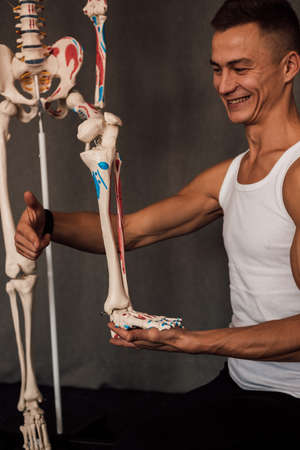Understanding Core Anatomy and Its Role in Spinal Health
When it comes to long-term spine health, the significance of a strong core cannot be overstated. The core is not just about visible abdominal muscles; rather, it is a complex network of deep and superficial muscles that work together to stabilise and support the spine. Anatomically, the core includes the transverse abdominis, internal and external obliques, rectus abdominis, multifidus, pelvic floor muscles, and the diaphragm. Together, these muscles form a cylinder around your midsection, providing both strength and stability. In everyday British life—whether youre commuting on the Tube, sitting at a desk in the office, or enjoying a brisk walk along the high street—a well-conditioned core helps maintain upright posture and reduces strain on your lower back. Good posture isn’t just for show; it prevents aches and injuries that can become chronic issues over time. Understanding how these muscles interact is essential: when your core is engaged properly, it acts as a natural brace for your spine during all sorts of activities—from lifting shopping bags to playing a round of cricket or simply tending to your garden. This foundational knowledge sets the stage for making informed choices about exercise routines that genuinely protect spinal health in the long term.
2. The Mechanics of Core Strengthening
Understanding the mechanics of core strengthening is essential for anyone seeking long-term spinal health. Scientifically, the “core” refers to a complex group of muscles including the deep abdominal muscles (such as the transverse abdominis), back extensors, pelvic floor, and even the diaphragm. These muscles work collectively to provide stability, facilitate movement, and protect the spine from excessive strain or injury.
Muscle Activation: Beyond Sit-Ups
Contrary to popular belief, core training isn’t just about endless crunches or planks. Effective core strengthening focuses on activating deep stabilising muscles rather than simply bulking up superficial ones. Research from UK-based physiotherapy studies highlights that targeted exercises like the dead bug or bird-dog promote balanced muscle activation patterns, which are far more relevant for spinal support in daily life.
Balance and Coordination: The Unsung Heroes
Developing core strength also means improving neuromuscular coordination – that is, how efficiently your brain communicates with your muscles. Balance exercises such as single-leg stands or using wobble boards stimulate proprioception (your body’s sense of position) and demand coordinated engagement from multiple core muscle groups simultaneously. This aspect is crucial for preventing falls and managing everyday movements with ease, especially as we age in the UK’s often unpredictable weather conditions.
Core Muscle Groups and Their Functions
| Muscle Group | Primary Function | Role in Spine Health |
|---|---|---|
| Transverse Abdominis | Abdominal compression and stabilisation | Acts as a natural corset to support the lower back |
| Multifidus | Spinal extension and rotation control | Maintains vertebral alignment during movement |
| Pelvic Floor Muscles | Support pelvic organs | Aids lumbar-pelvic stability under load |
| Erector Spinae | Spinal extension | Counters flexion forces and supports posture |
The Evidence for Long-Term Spinal Health
The British Journal of Sports Medicine reports that consistent core training improves postural endurance and reduces incidence of low back pain over time. Core-focused interventions have also been shown to enhance functional performance in everyday British activities – whether it’s gardening, cycling through city parks, or navigating crowded Tube stations. The key takeaway? Well-structured core routines foster resilience against both acute injuries and chronic spine conditions, cementing their value for lifelong spinal wellbeing.

3. Common Myths About Core Training in the UK
When it comes to core strengthening, a number of persistent myths circulate within British fitness circles and everyday conversations alike. One of the most widespread beliefs is that sit-ups or crunches are the gold standard for building core strength. While these exercises may seem effective, science shows they primarily target superficial abdominal muscles and place unnecessary strain on the lower back when performed incorrectly or excessively. For many Britons who spend long hours at desks or commuting, this kind of repetitive movement can actually exacerbate postural problems rather than resolve them.
Another misconception is that having a flat stomach equates to a strong core. In reality, true core stability involves much more than visible abs. The core encompasses deep stabilising muscles such as the transverse abdominis, multifidus, pelvic floor, and even the diaphragm. These muscles work together to support the spine during everyday activities like walking, lifting shopping bags, or simply standing in a queue.
Its also common in the UK to believe that core training requires expensive equipment or gym memberships. However, evidence-based practice highlights the value of functional movements—think planks, bird dogs, and dead bugs—that can be performed at home with minimal space and no specialist kit. The key for everyday Britons is consistency and form: focusing on slow, controlled movements while maintaining proper alignment.
Ultimately, effective core training is less about chasing six-pack aesthetics and more about developing balanced strength that protects the spine over a lifetime. By moving beyond outdated myths and embracing a more scientific approach, Britons can foster resilient backs that stand up to both daily demands and the occasional British rainstorm dash.
4. Practical Core Exercises for Daily Living
Strengthening your core doesn’t require a gym membership or perfect weather—especially important here in the UK, where rain is more common than a sunny spell. Instead, functional exercises that fit seamlessly into daily routines can offer measurable benefits for spinal health and resilience. Below, I’ll introduce some practical movements you can easily incorporate at home or even during work breaks, regardless of whether it’s bucketing down outside.
Everyday Core Movements
The goal of these exercises is to build stability and endurance in the core muscles that support your spine. These activities not only help maintain posture but also reduce the risk of back pain—a common complaint among Britons spending long hours at desks or commuting.
Simple Exercises to Try Indoors
| Exercise | Description | Recommended Reps/Sets | How It Supports Spine Health |
|---|---|---|---|
| Plank (Forearm) | Hold a straight body position on forearms and toes, keeping hips level. | 3 sets, 30–60 seconds each | Improves core stability and postural endurance, both key for spinal alignment. |
| Glute Bridge | Lying on your back with knees bent, lift hips towards ceiling while squeezing glutes. | 3 sets of 10–15 reps | Activates lower back and gluteal muscles, reducing stress on lumbar vertebrae. |
| Bicycle Crunches | Lying on your back, cycle legs and touch opposite elbow to knee. | 3 sets of 12 reps per side | Engages obliques and deep abdominal muscles crucial for rotational stability. |
| Standing March with Twist | Mimic a marching motion while rotating torso towards raised knee. | 2–3 sets of 20 steps | Builds dynamic balance and core control, mimicking daily movements like walking and bending. |
Tips for British Weather-Proof Routines
If you’re short on space or dodging the drizzle outdoors, remember that consistency matters more than intensity. Try integrating these exercises as “movement snacks” throughout your day: perform a set during tea breaks or before settling down to watch the telly in the evening. For those who commute by train or bus, simple standing core contractions (drawing belly button gently towards spine) help maintain engagement on the move.
The bottom line: building core strength is entirely achievable within the constraints of everyday British life—rain or shine. By prioritising these functional movements, you’ll lay the groundwork for long-term spinal health without needing to overhaul your entire schedule.
5. Long-Term Benefits: Beyond a Strong Back
When we talk about core strengthening, it’s easy to focus solely on having a resilient back or an improved posture. However, the science reveals that the benefits reach far beyond these immediate gains—especially as we age. For Britons, whose lifestyles can range from urban commutes and office hours to countryside rambles and gardening, a strong core is foundational for maintaining independence and enjoying everyday activities well into later life.
Improved Overall Mobility
A robust core acts as your bodys natural stabiliser. The muscles surrounding the abdomen, pelvis, and lower back work in harmony to support every movement—whether it’s reaching up for groceries in a high cupboard or navigating uneven pavements in rainy weather. Research indicates that individuals with well-developed core strength experience better balance and coordination, reducing the likelihood of falls—a particular concern as we get older.
Reduced Risk of Injury
Core strengthening doesn’t just protect your spine; it also reduces strain on other joints and muscles. With improved alignment and stability, you’re less likely to suffer from common injuries such as sprained ankles or pulled muscles during everyday tasks or recreational sports like tennis or golf. NHS guidelines consistently highlight core exercises in injury prevention strategies for all ages, underlining their importance in British health advice.
Enhancing Quality of Life
The cumulative effect of improved mobility and fewer injuries is a higher quality of life. A strong core enables you to participate confidently in social and physical activities—from brisk walks along the Thames to volunteering at local community events. Moreover, studies show that regular core strengthening can alleviate chronic pain, enhance mental wellbeing, and foster greater independence as we age—vital components for healthy ageing across the UK.
A Foundation for Healthy Ageing
In essence, prioritising core strength is an investment in your future self. By incorporating targeted exercises into your weekly routine, you lay the groundwork for a more active, enjoyable life—regardless of age. This holistic approach aligns perfectly with the British ethos of staying active and engaged within one’s community while maintaining personal autonomy for as long as possible.
6. Incorporating Core Training into British Lifestyles
Building long-term spine health through core strengthening requires more than just understanding the science—it’s about embedding practical habits into everyday British routines. Here’s how you can seamlessly incorporate core exercises into your lifestyle, making it both sustainable and relevant to the way people live and work across the UK.
Making Core Exercises a Daily Ritual
Start by linking core training to existing routines. For example, consider using the time waiting for your morning kettle to boil for a set of standing core twists or gentle planks. Little moments like these, repeated daily, help form lasting habits without overhauling your schedule.
Workplace Ergonomics: Supporting Your Spine on the Job
Many Britons spend significant hours at a desk. To counteract sedentary strains on the spine, adjust your workstation: ensure chairs provide lumbar support, keep screens at eye level, and use footrests if needed. Schedule brief hourly breaks—two minutes is enough—to stand, stretch, or perform simple seated core activations such as tightening your abdominal muscles or pelvic tilts.
Integrating Core Strengthening with Common Leisure Activities
The UK boasts a rich tradition of walking, cycling, and outdoor pursuits. Enhance these activities by engaging your core: maintain upright posture while strolling in the park, consciously brace your abs during a cycle ride, or add balance elements when hiking in the countryside. Even gardening offers opportunities—focus on controlled movements and safe lifting techniques to support your back.
Social Motivation and Accountability
Consider joining local fitness classes or community groups focused on pilates, yoga, or functional training—all excellent for core strength. Inviting friends or family to join you not only boosts motivation but also taps into the sociable nature of British culture. Sharing progress with others fosters accountability and enjoyment.
Consistency Over Intensity
Sustainable improvements stem from regularity rather than sporadic intensity. Aim for short sessions—ten to fifteen minutes daily is sufficient—rather than infrequent marathon workouts. Track progress in a journal or app; even modest milestones are worth celebrating.
Ultimately, integrating core training into British lifestyles involves small adjustments that fit around work, leisure, and social life. By choosing practical methods suited to your environment and culture, you’ll be investing in long-term spinal health without sacrificing enjoyment or balance in daily living.


